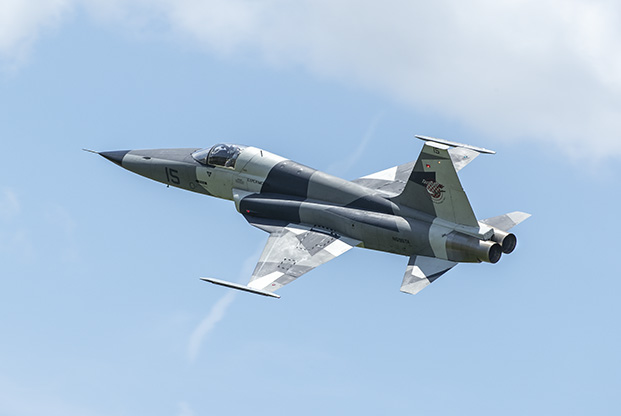
The Nevada-based Tactical Air Support Inc. won a five-year, $106.8 million contract to fly Red Air for the Navy. TacAir courtesy photo.
Tactical Air Support Inc. overcame a protest to win a five-year $106.8 million contract to fly Red Air for the US Navy, beating out the incumbent, which had been flying adversary missions since 1996, and three other firms.
The use of civilian aircraft to fly adversary missions is growing. The Air Force expects to preselect responsible vendors next year, with the ultimate goal of bringing on multiple civilian firms to share the Red Air mission with its own aggressor squadrons.
TacAir, of Reno, Nev., will support the Navy Fighter Weapons School known as TOPGUN and Carrier Air Wing Training with upgraded F-5E/F Advanced Tigers, acquired from the Royal Jordanian Air Force, said Mick Guthals, senior manager of business development.
The award was made six months ago, but Airborne Tactical Advantage Company, which had flown about 50,000 hours of adversary air for the Navy, protested, alleging that TacAir’s F-5s fell short of Navy requirements; that its radar integration and small, 21-aircraft fleet posed a “high risk,” and that its price was unrealistic. But GAO denied the protest and the deal is going forward.
ATAC, speaking through a spokesman, declined to comment to Air Force Magazine on Thursday.
The Navy contract required offerers to provide at least four mission-capable aircraft equipped with a radar warning receiver system and mechanically scanned array radar, while also having the ability to carry a tactical combat training system pod. The solicitation also offered “premium flight minutes” for aircraft equipped with active electronically scanned array radars.
Guthals said TacAir expects to fly about 1,700 hours per year and will have five F-5ATs on the ramp at Naval Air Station Fallon, Nev., during support periods. But he added the number of aircraft provided “can grow to 10-plus as the sorties increase.”
Naval Air Systems Command found both TacAir and ATAC’s final proposals to be technically “outstanding” with “low risk.” NAVAIR indicated it had “substantial confidence” in ATAC’s past performance, and “neutral confidence” in TacAir’s, according to the protest, but that the evaluated price of ATAC’s final proposal was $257.3 million, more than double that of TacAir’s final proposal.
ATAC, which was founded in 1994 by JD Parker, a 1988 Air Force Academy graduate and veteran of Operations Desert Shield and Desert Storm, is largely considered the “pioneer” of the contract adversary air industry, but competition has grown significantly in recent years. New rivals have entered the market in hopes of winning a piece of the Air Force’s anticipated multi-award contract for adversary air and joint terminal attack controller close air support.
The Air Force program is huge: The service is seeking about 30,000 annual hours of contract adversary air at 12 different USAF bases at locations inside the US, including Alaska and Hawaii, as well as roughly 10,000 hours of JTAC support, according to people familiar with the solicitation.
Final proposals for the Air Force’s CAF Contracted Air Support (CAFCAS) contract were due on Oct. 18 and the service is expected to award multiple indefinite delivery-indefinite quantity contracts in June 2019 with the expectation that the companies will start flying in late 2019-early 2020.
Both TacAir and ATAC submitted proposals to the Air Force, as did Draken International, which is currently flying Red Air at Nellis AFB, Nev., and Top Aces. Others may also have bid.
The Air Force in June awarded Draken a $280 million contract to continue flying adversary air at Nellis AFB, Nev., through December 2023. Draken has been the sole commercial provider of Red Air to the US Air Force since it received its first contract in 2015 to augment USAF’s existing F-16 aggressors. The Nellis contract is intended to be an interim solution until the CAFCAS contract goes into effect.
Draken has been growing its fleet in anticipation of that contract, announcing last year it had acquired 12 South African Atlas Cheetah supersonic fighters, in addition to its fleet of nine Aermacchi MB-339s, 27 MiG-21s, 21 L-159s, 22 F1s, 13 A-4s, five L-39s, and one T-33.
Textron Airborne Solutions, which bought ATAC in 2016, announced in September 2017 it had acquired 63 Mirage F1 aircraft formerly owned by the French Air Force, making it the world’s largest private supersonic air force.
And, Top Aces has a signed purchase agreement for 29 early block F-16s, which had been sold to a partner country through a foreign military sales agreement. Company officials say they plan to start bringing the fourth-generation fighters into the country as soon as the IDIQ contract is awarded.
All of the companies that make up this emerging market say they are constantly looking for new opportunities to grow their fleet.
“It is a fine balance between aircraft required and aircraft possessed,” said Guthals. “Like the services do today, our challenge is to provide sufficient aircraft to match the Air Force, Navy, and Marine Corps flying hour requirements without excess force structure. This maximizes the Air Force and navy value by not having excess hardware and liveware sitting around and not contributing to the mission.”